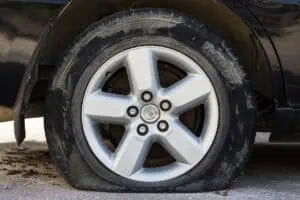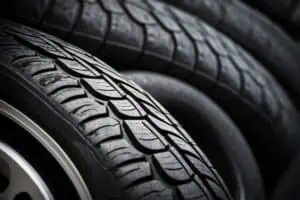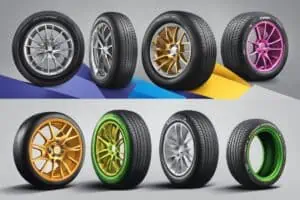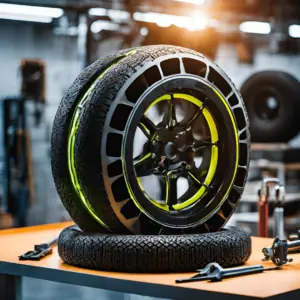Have you ever cruised down the highway when suddenly, the skies open up. Or maybe you’re facing an unexpected dusting of snow on your morning commute. In these moments, the rubber meeting the road becomes more than just a phrase – it’s the difference between confidence and concern. Welcome to the world of all-season and all-weather tires, where the nuances can make all the difference in your driving experience.
Tire Titans: All-Season vs All-Weather Showdown
At first glance, all-season and all-weather tires might seem like twins separated at birth. Both promise year-round performance, but dig a little deeper, and you’ll find that these tire types have distinct personalities. Let’s break it down:
All-Season Tires: Good At Many Things
All-season tires are your best friends of the tire world. They’re designed to handle a variety of conditions, from dry summer roads to light winter weather. Think of them as the friend who’s pretty good at everything but not necessarily an expert in any one area.
Key Features:
- Balanced tread design for year-round use
- Moderate traction in light snow
- Longer tread life
- Quieter ride
Best For:
- Regions with mild winters
- Drivers seeking versatility without frequent tire changes
- Those prioritizing fuel efficiency and low noise
All-Weather Tires: The Weather Soldier
All-weather tires are like all-season tires that decided to hit the gym. They offer enhanced performance in challenging weather conditions, particularly when it comes to rain, slush, and light snow. If all-season tires are your reliable friend, all-weather tires are that friend who always comes prepared with an umbrella and a first-aid kit.
Key Features:
- More aggressive tread patterns
- Enhanced wet and snow traction
- Three-Peak Mountain Snowflake (3PMSF) certification
- Improved cold-weather performance
Best For:
- Areas with frequent rain or light snow
- Drivers wanting better traction without switching to winter tires
- Those prioritizing safety in variable weather conditions
Tread Secrets: Unveiling the Design and Technology
Tread Patterns: The Tire’s Fingerprint
The tread pattern is like a tire’s fingerprint – unique and telling. All-season tires typically feature symmetrical or asymmetrical patterns with moderate siping (those small slits in the tread blocks). These designs aim to balance dry performance, wet traction, and light snow capability.
All-weather tires, on the other hand, often sport more aggressive tread patterns. You’ll notice wider grooves for better water evacuation and more siping for improved grip on snow and ice. It’s like comparing a pair of sneakers to a pair of hiking boots – both will get you where you’re going, but one is clearly more prepared for rough terrain.
Rubber Alchemy: The Compound Conundrum
The rubber compound is where tire manufacturers really flex their chemical muscles. All-season tires use compounds that aim to remain flexible across a wide temperature range, but they can harden in very cold conditions, reducing grip.
All-weather tires employ more advanced compounds that maintain flexibility in colder temperatures. This is crucial for maintaining traction when the mercury drops. It’s the difference between wearing a light jacket year-round and having a wardrobe that adapts to the seasons.
Road Test Revelations: Putting Rubber to the Road
Fair-Weather Friends: Dry Performance Face-Off
In dry conditions, all-season tires often have the edge. Their more balanced design provides better handling and a more comfortable ride on those perfect sunny days. All-weather tires, while competent, may feel a bit softer and less precise in these conditions.
Rainy Day Champions: Wet Weather Warriors
When the rain starts falling, all-weather tires begin to shine. Their more aggressive tread patterns and advanced compounds provide superior hydroplaning resistance and wet traction. All-season tires are no slouch in the rain, but they might not inspire the same level of confidence in a downpour.
Winter’s Challenge: Snow and Ice Showdown
Light snow is where the distinction becomes clear. All-weather tires, with their 3PMSF certification, offer noticeably better acceleration, braking, and handling in snowy conditions. All-season tires can handle a dusting, but they’re like trying to ice skate in sneakers – it works, but it’s not ideal.
Temperature Tango: Finding the Goldilocks Zone
All-season tires perform best in moderate temperatures, typically between 45°F and 80°F (7°C to 27°C). Outside this range, their performance can degrade. All-weather tires maintain better performance in a wider temperature range, particularly in colder conditions, making them more versatile for regions with variable climates.
The Great Debate: Pros and Cons Showdown
All-Season Tires: The Balanced Performer
Pros:
- Longer tread life
- Better fuel efficiency
- Quieter ride
- Excellent dry road performance
Cons:
- Limited performance in severe winter conditions
- Reduced traction in temperatures below 45°F (7°C)
- May require switching to winter tires in some regions
All-Weather Tires: The Versatile Virtuoso
Pros:
- Superior performance in wet and snowy conditions
- Eliminates the need for seasonal tire changes in many areas
- Better cold-weather traction
- 3PMSF certification for winter driving
Cons:
- Slightly reduced tread life compared to all-season tires
- May have a softer, less precise feel in dry conditions
- Potentially higher rolling resistance, affecting fuel economy
Tire Matchmaker: Scenarios and Recommendations
- The Urban Commuter’s Comfort Zone
If you’re driving mainly on well-maintained city roads in an area with mild winters, all-season tires are likely your best bet. They’ll provide the comfort, longevity, and fuel efficiency you need. - The All-Weather Adventurer’s Dream
For those living in areas with frequent rain, occasional snow, or rapidly changing weather conditions, all-weather tires offer the versatility and peace of mind you’re looking for. - The Four-Season Flexibility Seeker
If you experience all four seasons distinctly but don’t want the hassle of switching between summer and winter tires, all-weather tires provide a solid year-round solution. - The Snow Belt Survivor’s Essential
For those in areas with heavy snowfall, even all-weather tires may not be enough. Consider dedicated winter tires for the cold months and all-season or summer tires for the rest of the year.
The Rubber Meets the Road: Your Tire Decision
Choosing between all-season and all-weather tires is about understanding your specific needs and driving conditions. All-season tires offer a great balance for those in milder climates, providing comfort, longevity, and decent performance across a range of conditions. They’re the versatile performer in your tire lineup.
All-weather tires, with their enhanced wet and winter performance, are phenomenal for their multi purpose use for those facing more variable weather. They offer a “set it and forget it” solution that can handle most conditions Mother Nature throws your way.
Remember, no tire is a magic bullet. The best tire for you depends on your vehicle, driving style, and local climate. And regardless of your choice, regular maintenance – including proper inflation, rotation, and alignment – is key to getting the most out of your tires.
So, whether you’re leaning towards the balanced performance of all-season tires or the weather-ready grip of all-weather options, you’re now equipped to make an informed decision. After all, when it comes to your safety and comfort on the road, every choice matters. Happy driving, and may your journeys be smooth, regardless of what the sky decides to do!





























